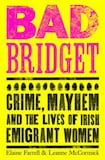
What differentiated 19th-century Irish emigration to the US from that of other countries was the number of young females who sailed, often unaccompanied, to new lives there.
Half of all Irish emigrants to the US between 1845 and 1885 were female, Bad Bridget tells us; thereafter, up to 1918, the percentage increased. Success for these girls and women would have been steady, paid employment in shops, mills or restaurants, or as domestic servants where, though wages were lower, their basic living expenses were provided for. Emigrant labour filled in where native-born American women deigned not to work.
The story of emigrant upward mobility is, in its most familiar form, one that began with 15-hour days of hard physical labour, with little protection or social opportunities, and much derision directed at these “Bridgets” or “Biddys”. With luck and graft it ended, perhaps, in a small family business, with a decently educated second generation and a secure foothold in the offices, police forces and schoolrooms of 20th-century America.
That’s the success story in outline form but, as Bad Bridget makes clear, not every Irish girl stepping off an emigrant ship walked into a wholesome or rewarding American life. Its catalogue of “criminal and deviant Irish women” draws upon six years of research in archives and historical records to uncover “the underbelly of Irish emigration to North America”. Its case studies show girls and women for whom the typical immigrant’s life was either unattractive or impossible, who instead resorted to schemes and practices that quickly landed them in various degrees of hot water.
Dancing with the Stars: ‘I’ve had the best time of my life. I feel super fit,’ chef Kevin Dundon says as he is voted off show
Oscars 2025 red carpet: Ariana Grande sets the standard while Timothée Chalamet stood out in ‘Kerrygold’ yellow
Róisín Ingle puts a Thermomix to the test: ‘I am a convert but there’s one enormous catch’
Life without children: ‘I’d want the investment my mother had, but I don’t have it in me. I don’t have the grá for it’
Some were likely of criminal bent and possibly would have been on bad terms with the law, had they stayed in Ireland. For most others, dismissal from a job or failure to find one in America exposed them to immediate and dire need. In an environment without any economic safety net or the support network of extended family, on top of what might have been a traumatic wrench from home, the line between upstanding competent and deviant reprobate may have proved surprisingly porous.
That isolation, scant education, poverty and desperation rarely lead to advancement will come as news to none. Some may have chosen lives of crime but, in a world where girls could be sent to reformatory prison for “stubbornness” (As Ellen Nagle was, in 1903), deviance could also be a matter of (invariably male) interpretation. What Bad Bridget so thoroughly illustrates is how shockingly easily these cited Irish immigrant women slipped from (however fragile) respectability into lives of alcoholism, prostitution, petty crime and, sometimes, extreme violence.
At the shallow end are pickpockets, shoplifters, or “panel house thieves”, who sprung out of hidden wall panels in brothels to steal money or valuables while the client was otherwise engaged. Then there were the prostitutes themselves, nightwalkers or women who worked in brothels (including one Eliza Thompson who, upon arrival in New York in 1858, asked the trolley conductor for the name of a respectable boarding house, only to find herself deposited instead at a brothel, where her money and luggage were confiscated).
Other crimes presented here include kidnapping, extortion, and, at the deep end, murder. Crimes of passion, alcohol-fuelled rage, jealousy or retribution illustrate the book’s final sections, culminating in the story of Mary Farmer, who emigrated about 1900, working first as a servant before trying (and failing) to establish her own boarding house. In 1909, Farmer was convicted of fatally stabbing her friend and neighbour, Sarah Brennan, and taking possession of her house (in which she had stowed Sarah’s body, in a locked trunk). The book concludes with a description of Mary, “dressed in a plain black blouse and skirt with her hair pulled tightly into two plaits” (sounding, for all the world, like a domestic servant in the uniform she’d previously cast off), achieving the dubious distinction of becoming only the second woman to be electrocuted in the state of New York.
[ Bad Bridgets: The murderers, thieves and prostitutes among Irish emigrant womenOpens in new window ]
Bad Bridget presents fascinating case studies of women whose life stories are a matter of court records, prison files, and the admission and discharge books of various mental institutions and reformatories in New York, Boston and Toronto. Individually, the stories are dramatic and vivid, full of the kind of lurid detail that made the related Bad Bridget podcast so popular. But their narrative specificity is also something of a limitation in that, relying on the routine use of phrases such as “many women” or “one of several”, the particularity of the stories can make it difficult to sense just how common they were to immigrant life. (Perhaps the book title should have “Some” inserted before “Irish Emigrant Women”?) But when it pans out to include statistical context and historical oversight, Bad Bridget is at its strongest in suggesting not alone individual lives but patterns of experience.
The emigration story we mostly tell ourselves is a bright, shiny one to which Bad Bridget now adds invaluable corrective shading. Its haul of previously underused primary source material will certainly change how we understand that story, and allow us to tell it with more nuance and complexity, and truth.
- Vona Groarke’s latest work is Hereafter: The Telling Life of Ellen O’Hara (NYU Press)














